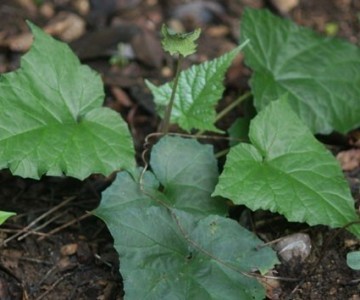Tusilla
(Dorstenia contrajerva)

Description
Dorstenia contrajerva is a plant species in the family Moraceae. It is native to Northern South America and Central America, and is cultivated elsewhere. The species name "contrajerva" is the Latinized form of the plant's Spanish name, "contrahierba," a name for plants used for treating poisoning and venomous bites and stings, and for which its rootstocks are used in folk medicine (as contrayerva). It is the type species of the Dorstenia genus and was first described by Carl Linnaeus in 1753. Dorstenia contrajerva is a small evergreen perennial plant with a creeping rhizome from which emerges a rosette of leaves with long petioles. Leaves are variably shaped, with plants with lobed and unlobed leaves co-occurring in the same populations. Leaves are up to 20 cm long on petioles up to 25 cm long. When damaged the plant exudes a white latex. Tiny male and female flowers are distributed intermixed on a discoid receptacle of convoluted shape. The fruits are small and contained in a quadrangular container. The tiny seeds are explosively expelled. Plants acaulescent or nearly so. The stems, if any, are very short and covered with persistent petiole bases. Leaves are often very numerous and crowded. Stipules persistent; petiole 8–25 cm. Leaf blade long-petiolate, oblong-ovate, deltate-ovate, or orbiculate, entire or deeply pinnately or almost palmately lobed, 6-20 × 7–22 cm, sparsely scabrous or pubescent. The lobes acute to acuminate, narrow or broad. Inflorescences: receptacle flat, curved, or undulate, quadrangular or irregularly lobed, accrescent in age and 2–5 cm. wide, scaberulous beneath. On long slender peduncle, 7–25 cm. Drupes somewhat globose, 0.25–1 cm in diameter. Seeds yellowish. 2 n = 30. In the United States Pharmacopoeia and the National Formulary (1927), the rhizome of Dorstenia contrajerva or Contrayera is described as fusiform, 1–2 headed, 5–7.5 cm long, 12 mm thick, reddish, with an unpleasant odor and acrid, bitter taste. Dorstenia contrajerva is native to southern Mexico, Central America, the Caribbean and northern South America including Peru. It is cultivated in Indonesia (Java) and Malaysia (Malacca), and locally in Africa and South America. In North America Dorstenia contrajerva has been introduced to Florida and is a weed in greenhouses and nurseries. It is sometimes cultivated as a house plant.
Taxonomic tree:







